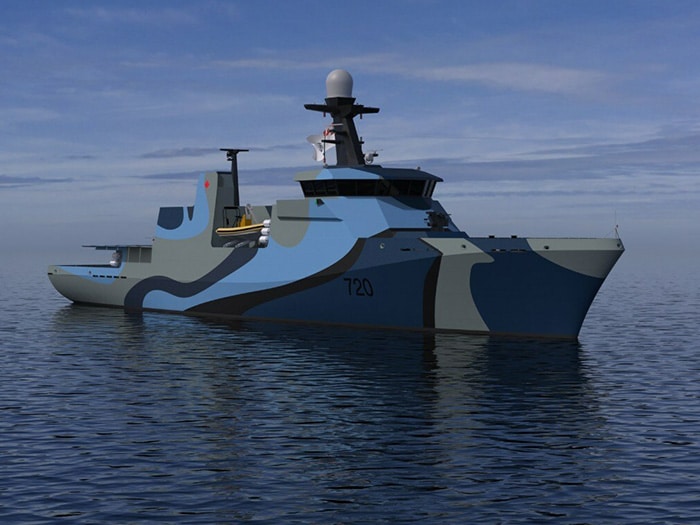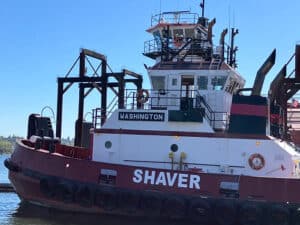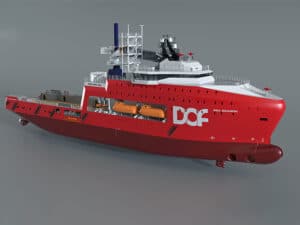
Canadian shipbuilding sees productive year
Written by Alex Marcheschi
Team Vigilance released this rendering of the Vigilance class OPV. (Credit: Team Vigilance)
Key Canadian shipyards are staying busy with new orders and repairs, while naval architects help take these projects to the next level.
The Royal Canadian Navy is at the center of shipbuilding news in Canada as naval vessel replacements and new ideas are spurring the industry forward in once heavily active port cities like Ontario.
Fincantieri’s Canadian-headquartered Vard Marine Inc. naval architecture and marine engineering subsidiary unveiled its design for the Vigilance-class Offshore Patrol Vessel at CANSEC in Ottawa in early June. Vard Marine is part of Team Vigilance, which is launching the Vigilance-class as a candidate to replace the Royal Canadian Navy’s Kingston Class Maritime Coastal Defense Vessels.
The U.S. Coast Guard’s 110-meter Heritage-class Offshore Patrol Cutter is based on Vard Marine’s VARD 7 110 Offshore Patrol Vessel design. Vard has since then developed a 115-meter next generation offshore patrol vessel (NGOPV) design, the VARD 7 115 NGOPV. The other Team Vigilance members are Heddle Shipyards, Thales Canada, SH Defense, and Fincantieri.
Heddle Shipyards, says it will leverage the team’s broad experience to realize the underutilized capacity at its Ontario shipyards to meet the future needs of the Royal Canadian Navy. Established in 1987, Heddle Shipyards is a Canadian-owned company and the fastest-growing Canadian shipyard on the Great Lakes.
“Ontario was once the epicenter of shipbuilding in Canada. We have the capacity needed to deliver the Vigilance Class Offshore Patrol Vessel,” says Shaun Padulo, president and CEO of Heddle Shipyards. “With the support of our Team Vigilance partners, we will harness this capacity to support the second pillar of the National Shipbuilding Strategy and activate Ontario’s manufacturing and industrial sector to support the National Shipbuilding Strategy (NSS).”
Thales role in Team Vigilance will be to provide Combat Systems Integration (CSI) and Electronic Systems Integration (ESI) for the Vigilance class OPV, while SH Defense, part of the Svendborg, Denmark-headquartered SH Group, is the developer of the Cube interchangeable mission modules for air, surface and subsea capabilities.
Canada has an NSS that is a long-term project to renew Canada’s federal fleet of combat and non-combat vessels. Partnerships have been formed with three Canadian shipyards to deliver much-needed vessels to the Royal Canadian Navy and the Canadian Coast Guard.
Seaspan’s Shipbuilding Advances Under NSS
Seaspan Shipyards, Vancouver, B.C., which along with Irving Shipyards was one of the two initial lead shipyards selected to participate in Canada’s National Shipbuilding Strategy, has awarded three contracts, totaling approximately CAD 2.6 million, to enable four Canadian companies to advance marine industry digitalization and further modernize shipbuilding and fleet maintenance.
In March 2022, Seaspan launched its HoloShip platform, an immersive visualization system that allows designers, engineers, production teams, and customers to virtually experience a fully detailed, three-dimensional, and accurate digital model of a vessel, using an integrated 5.6-meter-wide display wall and virtual reality headsets.
The HoloShip platform and the projects now being announced are part of Seaspan Shipyards’ value proposition commitments under Canada’s NSS. In addition to providing funding, Seaspan will give the four companies — Gastops, BCS Automation, 3GA Marine and Kognitiv Spark access to its HoloShip platform and to its decades of shipbuilding expertise and use cases.
To further advance its shipbuilding capabilities, Seaspan has begun construction on a new Land-Based Test Site at Vancouver Shipyards that will integrate and test vital ship communications, navigation, and other electronic equipment prior to being installed on vessels. Seaspan is the first shipyard in Canada to co-locate this facility within the shipyard and marks another investment in driving efficiency in Seaspan’s shipbuilding capabilities.
The new $4.8-million facility will play an important role in Seaspan’s work under the NSS, including a dedicated antenna tower and platform that will enable our team to conduct design development, systems integration, and test and validation work for the electronic equipment onboard the Polar Icebreaker and Multi-Purpose Vessels that Seaspan is building for the Canadian Coast Guard.
Davie Joins NSS
Additionally, Canada’s largest shipbuilder, Davie Shipbuilding Canada Inc., has now become an official partner in Canada’s NSS. In April, Prime Minister Justin Trudeau said that this deal marked the start of negotiations for contracts to support Canada’s future shipbuilding including the construction of six program icebreakers and one polar icebreaker for the Canadian Coast Guard. According to Davie, the initial work package also includes two large hybrid-powered ferries.
“This historic agreement puts the ‘National’ in National Shipbuilding Strategy and the federal government deserves much credit. Together, we will bridge a strategic shipbuilding gap and create guaranteed capacity for future fleet renewal at Canada’s largest shipbuilder,” says James Davies, president and CEO of Davie. “It is an acknowledgement of everything Davie has achieved over the past decade, our expertise, and the quality of our Quebec-based workforce. We can now get to work delivering the icebreakers Canada urgently needs to meet its growing responsibilities as an international Arctic presence, while fulfilling its critical southern wintertime mission to keep our economy flowing.”
In its announcement of the agreement, the Government of Quebec noted that it was supporting a CAD 840 million modernization program at the shipyard with CAD 519.2 million of funding.
“We also commend the Government of Quebec for supporting our journey to become one of the most advanced shipbuilding facilities in North America,” says Davies. “The NSS will be a springboard to create an internationally competitive shipbuilding hub in Quebec. We will generate and showcase Quebec innovation and talent as we build cutting-edge ships, which are in high global demand.”
Ferry Redelivery
The announcement was on the heels of the redelivery of the Société des traversiers du Québec (STQ) ferry MV Félix-Antoine-Savard by Davie Shipbuilding after repairs that required over 30,000 hours of work, and the replacement of 28 tons of steel.
The ferry, which operates between L’Isle-aux-Coudres and Saint-Joseph-de-la-Rive in Quebec, was involved in a grounding incident early in the year and though it managed to free itself some 90 minutes later, it required what turned out to be extensive repairs. Davie crews worked round-the-clock, seven days a week, to repair the MV Félix-Antoine-Savard as quickly as possible so that it could be put back into service. This constant rotation of work considerably shortened the ship’s drydocking period, reducing the initially scheduled repair time by about 10 days.
“Our employees deserve huge credit for their hard and smart work over the past 10 years,” says Alex Vicefield, chairman and CEO of Inocea, the parent company of Davie Shipbuilding. “They have helped demonstrate that Canada and our facility is an innovative and internationally competitive shipbuilder. Davie has and will continue to set a new standard in North American shipbuilding. The historic commitment by Canada and our industry-leading facility and global network are a winning combination that will see us create a sustainable export-driven industry.”




